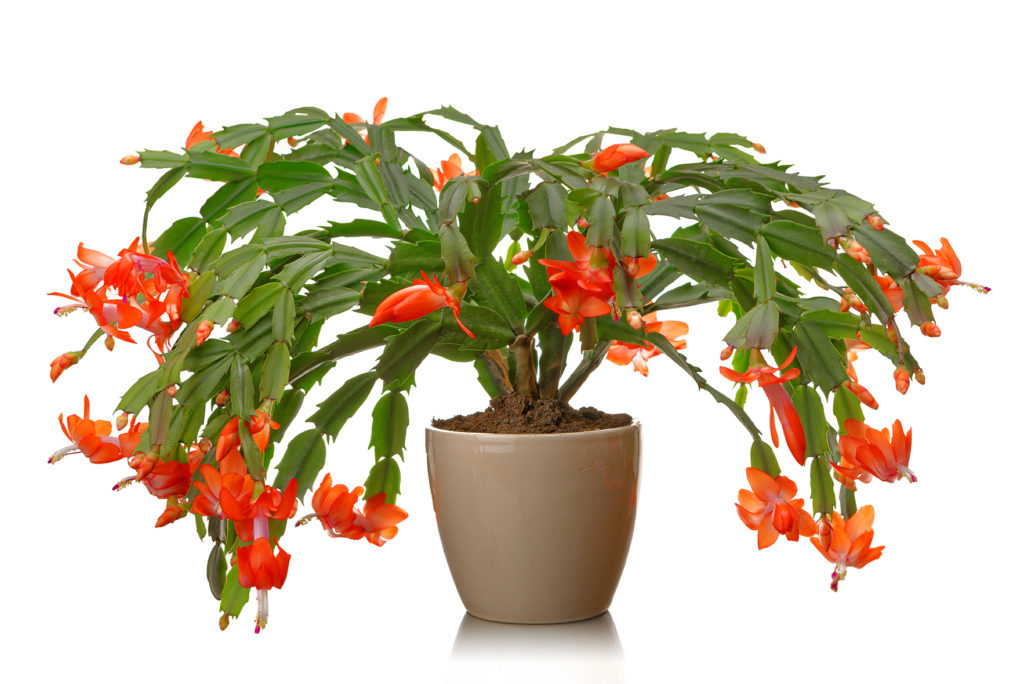Q. I want to transplant my blooming Christmas Catcus into another pot, but I’m scared to touch it. Can I move a blooming plant to another pot without shocking it?
A. It’s okay to transplant a Christmas Cactus and most other plants while they are in bloom. This is when an evergreen plant is technically dormant, as it’s not actively growing. There is no reason why you have to wait until it finishes flowering. I’d transplant it carefully as not to damage the flowers.
Christmas Cactus is also known as the Zygocactus or crab cactus because of its segmented leaves. Along with Cyclamen, they are a great red and white alternative to poinsettia during the holiday season. Zygocactus and Cyclamen are not sensitive to warm rooms, as is a Poinsettia, so the foliage doesn’t discolor quickly and has a long blooming period.
Q. I’m not sure when to prune my Raspberry plants. When should I? They still have lots of foliage and some fruit.
A. The best time to prune Raspberries is after the berries have been harvested. Also, Blackberries are pruned the same. The timing varies depending on the variety, as some varieties bear two crops while others only one. If the remaining fruit hasn’t ripened by now, I don’t believe it will. So go ahead and prune anyway. If the fruits are very hard and only half have turned color, you have a Berry Mite problem. Berry Mite is only controllable during the dormant season with Bonide All-Season Oil or similar Horticultural Oil. The pruning technique is straightforward if the plants are being grown on a trellis. The fruit-bearing canes are removed entirely by cutting them off at the ground, as they’ll never produce berries again. The next crop will be borne on the new shoots found at the base of the plants. They’re tied to the trellis structure. A fence makes a very poor trellis for berry vines. Your next store neighbor will not appreciate the thorny and aggressive habit exhibited by the intruding vegetation. Berry vines are best grown four feet off the fence line to control the underground stems called rhizomes. It is recommended you be pro-active in keeping the vines under control to prevent a costly neighbor dispute. Many yards are too small to grow cane berries effectively.
Q. I bought a ph test kit to check the soil around my Wisteria because it has not been doing well. I was surprised that the soil pH tested around 4. I expected it to be low because I’m using well water. How would I raise the pH to about 6.5?
A. Raising the soil pH is not a question that I frequently receive. It’s more of a problem in the Midwest or where Acid Rain is prevalent. Our clay soil tends to be alkaline, so gardeners are more likely to lower it, and a 4.0 reading from well water is unusual. That being said, you increase the soil pH by adding lime or limestone, calcium carbonate, a naturally occurring rock. Agricultural Lime or “Aglime,” is crushed limestone, and you’re likely to find it at an independent garden center than a Big Box Retailer or online. Limestone again, calcium carbonate is not to be confused with hydrated lime, calcium hydroxide. They’re not the same. You’d apply five pounds per hundred square feet in clay soil, which more than you need around a single plant. So, I’d spread a three to four generous hand full under the canopy of the Wisteria. It’s then cultivated into the soil, and you let the winter rains do the rest. It’s very dusty, so use a mask. I also have found Wood Ashes and Baking Soda could be used as a short-term solution. The quantity necessary is a bit shaky, so I’d stick to Agricultural Lime.
Q. Our lemon tree seems to be dying as the leaves are falling off. It started after our Hot Tub developed a significant leak. Bromine and other chemicals in the water flooded the area. What will the bromine do to the tree?
A. Lemons do not tolerate high levels of bromide, and it’s the cause of the leaf drop. The stems and branches then turn brown and die. The immediate solution would to water heavily with clean water to leech the bromine out of the root zone. However, the area was flood with contaminated water, so that isn’t an option. The rainy season will help, but it may be too late. There isn’t much else you can do but wait for spring. If you don’t see any new growth by next May, I’d replace the lemon,

Leave a Reply